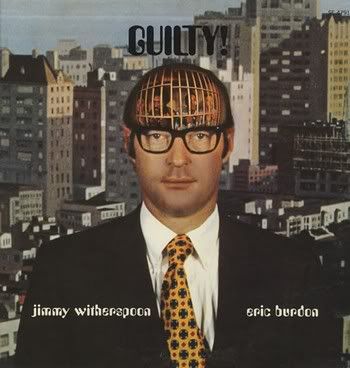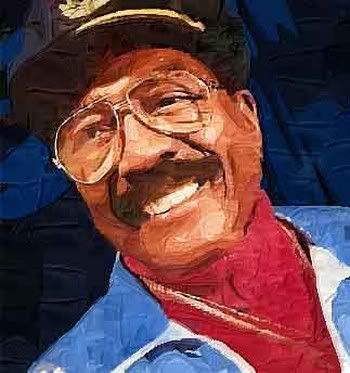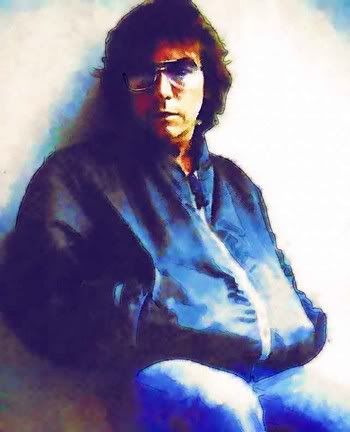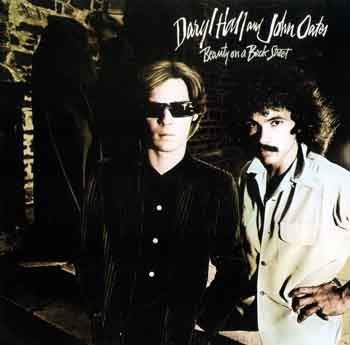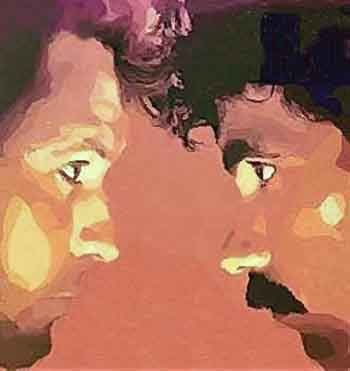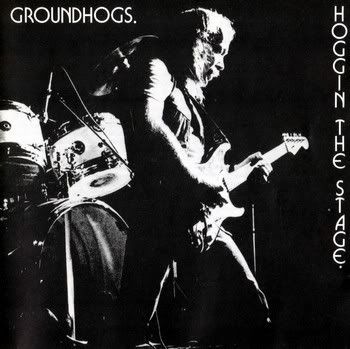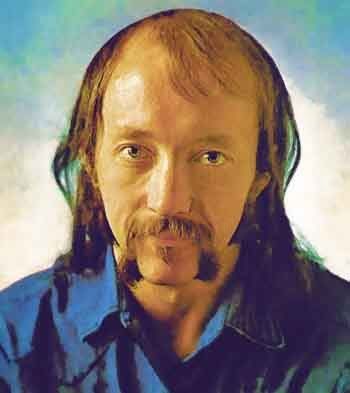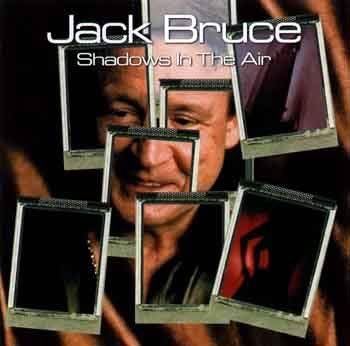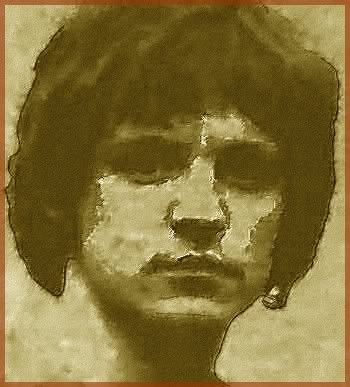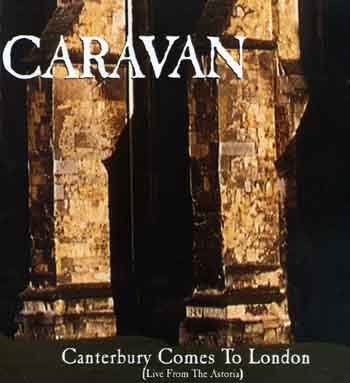
Caravan - Canterbury Comes To London: Live From Astoria - 1997 - HTD/Castle/Transatlantic
Caravan were one of the great "Canterbury Rock" bands to emerge from England in the late sixties. They produced a unique blend of progressive psychedelic rock and jazz, and made some great albums. They were never a commercial band, and have always played what THEY like. It's not easy, and was never easy to retain your musical integrity, and Caravan never achieved the fame they deserved, although they have had a loyal hard core following for nearly forty years now. "Live From Astoria," recorded in September 1997 at The Astoria, London, England, is a great album and proves the amazing innovativeness of this great band. Check their debut s/t "Caravan", and their outstanding 1971 "Land Of Grey And Pink" albums. Their "Waterloo Lily" album is a brilliant English jazz rock album. N.B: "Caravan - Canterbury Comes To London" has been re-issued in many editions, on various labels, but of them have the same tracks. For music in the same genre, check out albums by "Matching Mole" and "Hatfield and the North."
TRACKS / COMPOSERS
01 Memory Lain, Hugh - Hastings
02 Headloss - Hastings
03 Nine Feet Underground - Coughlan, Hastings, Dave Sinclair,Richard Sinclair
04 The Dog, the Dog, He's at It Again - Hastings
05 Cold as Ice - Hastings
06 Somewhere in Your Heart - Hastings
07 I Know Why You're Laughing - Hastings
08 Liar - Hastings
09 For Richard - Coughlan, Hastings, Dave Sinclair,Richard Sinclair
10 Golf Girl - Coughlan, Hastings, Dave Sinclair,Richard Sinclair
MUSICIANS
Doug Boyle (Guitar), (Guitar (Electric))
Pye Hastings (Guitar), (Vocals)
Jim Leverton (Bass),(Vocals)
Dave Sinclair (Keyboards)
Geoffrey Richardson (Flute), (Mandolin), (Viola), (Spoons)
Richard Coughlan (Drums)
Simon Bentall (Percussion)
Rob Williams, Dave Woolgar (Recorders)
REVIEW
Rarely do reformations of classic rock bands equal the work of the unit to gain initial notoriety. Since their semi-permanent reunion in the '80s, Caravan have not only reworked some of their most beloved works on studio releases such as All Over You and the follow-up, All Over You Too, but the band has also made numerous live recordings highlighting enthusiasts favorites as well as newer material, such as Pye Hastings ballad "Cold As Ice." Canterbury Comes to London is one of the better live performance recordings to feature core band members (Pye Hastings, Geoffrey Richardson, Dave Sinclair and Richard Coughlan) as augmented by other non-Caravan alumni. Notable for their tenure in this incarnation is lead guitarist Doug Boyle -- who is probably best known as Robert Plant's post Robbie Blunt solo axe man. Jim Leverton is another addition whose long and varied residencies include Fat Mattress, Savoy Brown, and Juicy Lucy. Sadly, percussionist Simon Bentall's augmentations seem consistently out of place. The glaring chime crescendos during "Golf Girl" or the needless, yet incessant, tambourine fills and bongo fury which obscure an otherwise striking rendition of "Memory Lain, Hugh" and "Headloss" bear the deepest scars. Conversely, his restraint on "Nine Feet Underground" is duly noted. Enthusiasts whose interest began to wane in Caravan's post- Cunning Stunts era will, at the very least, be pleasantly surprised at the residual intensity and attack which are readily displayed throughout this live set. Immediately the togetherness of the band is demonstrated during the multi-rhythmic passages of "Headloss," as well as throughout "For Richard." There are no lagging tempos, forgotten lyrics, or neglected solos here. Caravan's motifs of musical economy while providing multi-hued sonic canvases are alive and well as Canterbury Comes to London. © Lindsay Planer, All Music Guide
ABOUT CARAVAN
Caravan was one of the more formidable progressive rock acts to come out of England in the 1960s, though they were never much more than a very successful cult band at home, and, apart from a brief moment in 1975, barely a cult band anywhere else in the world. They only ever charted one album in their first six years of activity, but they made a lot of noise in the English rock press, and their following has been sufficiently loyal and wide to keep their work in print for extended periods during the 1970s, the 1990s, and in the new century. Caravan grew out of the breakup of the Wilde Flowers, a Canterbury-based group formed in 1964 as an R&B-based outfit with a jazzy-edge. The Wilde Flowers had a lineup of Brian Hopper on guitar and saxophone, Richard Sinclair on rhythm guitar, Hugh Hopper playing bass, and Robert Wyatt on the drums. Kevin Ayers passed through the lineup as a singer, and Richard Sinclair was succeeded on rhythm guitar by Pye Hastings in 1965. Wyatt subsequently became the lead singer, succeeded by Richard Coughlan on drums. Hugh Hopper left and was replaced by Dave Lawrence then Richard Sinclair, and Dave Sinclair, Richard's cousin, came in on keyboards. Finally, in 1966, Wyatt and Ayers formed Soft Machine and the Wilde Flowers dissolved. In the wake of the earlier group's dissolution, Hastings, Richard Sinclair, Dave Sinclair, and Richard Coughlan formed Caravan in January of 1968. The group stood at first somewhat in the shadow of Soft Machine, which became an immediate favorite on the London club scene and in the press. This worked in Caravan's favor, however, as the press and club owners began taking a long look at them because of the members' previous connections. A gig at the Middle Earth Club in London led to their being spotted by a music publishing executive named Ian Ralfini, which resulted in a publishing deal with Robbins Music and then, by extension, a recording contract with MGM Records on their Verve Records imprint, which the American label was trying to establish in England. Their self-titled debut album was a hybrid of jazz and psychedelia, but also enough of a virtuoso effort to rate as a serious progressive rock album at a time when that genre wasn't yet fully established; along with the the Nice albums on Immediate and The Cheerful Insanity of Giles, Giles & Fripp, it planted the roots of progressive rock. The Caravan album never sold in serious numbers, and for much of 1968 and early 1969, the members were barely able to survive -- at one point they were literally living in tents. And then, to add insult to injury, the record disappeared as MGM's British operation shut down in late 1968. Out of that chaos, however, the group got a new manager in Terry King and, with the help of a fledgling producer named David Hitchcock (who'd seen the band in concert), a contract with England's Decca Records, which was a major label at the time. Their Decca debut album, If I Could Do It All Over Again, I'd Do It All Over You, released in early 1970, was a major step forward and, indeed, a milestone in their history, establishing the mix of humor and progressive sounds, including classical, jazz, and traditional English influences that would characterize the best of their work over the next six years. Moreover, with Decca's then-formidable distribution behind it, the album got into stores and was heard and even sold well on university campuses. Suddenly, Caravan was an up-and-coming success on the college concert circuit, even making an appearance on British television's Top of the Pops. With national exposure and a growing audience, the group was at a make-or-break moment in their history. They rose to the occasion with their second Decca LP, In the Land of Grey and Pink, which showed off a keen melodic sense, a subtly droll wit, and a seductively smooth mix of hard rock, folk, classical, and jazz, intermingled with elements of Tolkien-esque fantasy. The songs ranged from light, easy-to-absorb pieces such as "Golf Girl" to the quietly majestic "Nine Feet Underground," a 23-minute suite that filled the side of an LP. One of the hardest-rocking yet musically daring extended pieces to come out of the early progressive rock era, "Nine Feet Underground" didn't seem half as long as its 23 minutes and it was a dazzling showcase for Pye Hastings' searing lead guitar and Dave Sinclair's soaring organ and piano work. Although few observers realized it at the time, the suite's length pointed up a problem that the group faced fairly consistently -- in contrast to most progressive rock outfits of the era, Caravan was inventive enough to justify extending even the relatively simple songs in their repertory to running times of six or seven minutes, and they were also extremely prolific. Those two situations meant that they were frequently forced to leave perfectly good songs off their albums and to edit those that they did issue. Most listeners didn't find this out until a wave of Caravan reissues arrived in 2001 with their running times extended 10-25 minutes each by the presence of perfectly good, previously unissued songs and unedited masters of previously released songs. Keyboard player and singer Dave Sinclair left the group's lineup in 1971, joining his ex-Wilde Flowers bandmate Robert Wyatt in the latter's new group, Matching Mole, and he was succeeded by Stephen Miller of the jazz-based band Delivery, who lasted through one album, Waterloo Lily" (1972), moving them in a much more bluesy direction. Friction between the members resulted in Miller's departure and the exit of Richard Sinclair, who subsequently put together Hatfield and the North. When the smoke cleared, Caravan was back as a five-piece which included Geoff Richardson on the electric viola, which added a new and rich timbre to their overall sound. By the time they cut their next album, For Girls Who Grow Plump in the Night, Dave Sinclair was back on keyboards. The album was a success, as was its follow-up, Caravan & the New Symphonia, a live 1973 performance accompanied by a full orchestra, released the following year. The group was poised to try for a breakthrough in America and, toward that end, took on Miles Copeland as their manager. They ended up on a 50-date tour of the United States and Canada where the response was positive. They also released a new album, Cunning Stunts, that became their first chart LP, not only in England but also in America (albeit at number 124) and most of Europe as well. Unfortunately, Cunning Stunts, for all of its sales success, was an ending rather than a new beginning -- the group parted company with Decca Records after its release. They recorded Blind Dog at St. Dunstan's for the Copeland-owned BTM Records the following year, and Better by Far for the Arista label the year after that, but by that time, their moment seemed to have passed, and they seemed increasingly out-of-step with the burgeoning punk rock boom. Caravan ceased activity in the early '80s, following the release of The Album and Back to Front, both recorded for Kingdom Records, owned by their former manager Terry King. Their history seemed to have ended, and then in 1990, the original quartet of Pye Hastings, Richard Sinclair, Dave Sinclair, and Richard Coughlan were reunited for what was supposed to be a one-off concert for a television special. The performance and the sales of an accompanying live album proved so encouraging that Caravan came together once more for a second career. The group has been back together in one lineup or another ever since, (mostly filled out by ex-members of Camel, among other latter-day personnel), with new recordings emerging steadily. Equally important, someone at English Decca (by then part of Polygram, which became part of MCA) took it upon themselves to raid the vaults in 1999-2000 and prepare vastly expanded reissues of the group's entire Verve/Decca catalogs. The result was the availability of more Caravan music and more of their classic '60s and '70s recordings than had been in print at any time in their history. © Bruce Eder, All Music Guide
BIO (Wikipedia)
Caravan are an English band from the Canterbury area, founded by former Wilde Flowers members David Sinclair, Richard Sinclair, Pye Hastings and Richard Coughlan. Caravan rose to success over a period of several years from 1968 onwards into the 1970s as part of the Canterbury scene, blending psychedelic rock and jazz to create a distinctive sound like their contemporaries Soft Machine. Caravan still remains active as a live band in the 21st century. Following the dissolution of their former band, Wilde Flowers, David Sinclair, Richard Sinclair, Pye Hastings and Richard Coughlan formed Caravan in 1968. The band became the first British act to sign for American record label, Verve, who subsequently released the band's debut LP, Caravan, later the same year. After this Verve closed their rock and pop division, causing Caravan to move to Decca Records for the release of If I Could Do It All Over Again, I'd Do It All Over You in 1970, from which the title track gained the band an appearance on Top Of The Pops, and then Deram (Decca's progressive subsidiary) for 1971's In the Land of Grey and Pink. After the third album's release Sinclair chose to leave the group, to be replaced by Steve Miller. The change in keyboardist caused a change in musical direction, and the band's next album, Waterloo Lily, was distinctly more jazz influenced than earlier work. This caused some unrest for followers of the group, and the band disintegrated soon after Waterloo Lily's release, leaving just Hastings and Coughlan. The duo recruited viola player Geoffrey Richardson, bassist Stu Evans and keyboardist Derek Austin and toured extensively. This line-up did not make any recordings before Evans was replaced by John Perry and Dave Sinclair rejoined the group in 1973. The resulting album For Girls Who Grow Plump in the Night was cited as a return to form and is now heralded as one of the group's finest moments. A regular cult favourite, the band's chart performance in the UK and US was minimal, charting one album, Cunning Stunts at US#124. In the UK, Cunning Stunts (#50) and Blind Dog at St. Dunstan's (#53) were their only hits. A loyal following has ensured steady back catalogue sales and a lengthy live career for the band, who continue to this day featuring founder members Pye Hastings (guitar, vocals, songwriting) and Richard Coughlan (drums). Caravan's best-known recording is the 1971 set In the Land of Grey and Pink, their second album for Decca. 30 years after it's release this album finally received a platinum disc for sales of over 100,000. It has been said of that album that it "showed off a keen melodic sense, a subtly droll wit, and a seductively smooth mix of hard rock, folk, classical, and jazz, intermingled with elements of Tolkien-esque fantasy".A fair summary of Caravan's late sixties to late seventies work. Prolific and inventive, the band appeared to have too many ideas to produce direct, radio-friendly singles. 21st century reissues of their albums featured lengthy tracks, previously unissued, demonstrating the huge amount of releasable material that had failed to make their 1970s albums. The band were largely dormant in the eighties until a 1990 reunion, planned as a one-off for television, restarted their career. Latterly they have also achieved steady sales and a fan following with the support of the more eclectic corners of radio, like BBC Six Music's "Freak Zone" and the growing re-emergence of progressive rock. They released Unauthorised Breakfast Item album in 2003.


